Project Log: Saturday, March 3, 2012
My first task was to unclamp and trim to size the panels
I'd glued up yesterday; I'd let the black Kydex run a
little long over the edges rather than try to glue and
align pieces that were exact size. The material
had bonded well to the wood, so I harbored no further
worries about that.
I test-fit both panels in the console and made any fine
adjustments necessary. I'd left the lower
instrument panel wider than necessary so I could
mark the bottom angle cut in situ for a more
precise fit; this photo shows the panel before I'd made
the final cut. |
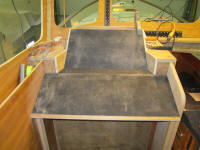 |
Before making any layout or cuts on the panels, I
covered the surfaces with masking tape, both to give me
a surface to mark on, and also to provide some
protection during cutting. To begin, I prepared
the mounting template for my navigation display, a
Simrad NSE 8, and positioned the template on the panel
where I wanted it, checking the dimensions several times
and placing the panel in the boat to ensure the unit was
positioned where I wanted. |

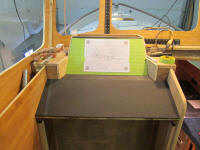 |
Next, I made the cuts as required, and installed the
panel in the boat. I wanted to keep these
instrument panels removable for access or eventual
reconfiguration down the line; I wanted to use black
screws to minimize their appearance, but didn't have the
correct ones in stock, so I ordered what I needed and
used some regular stainless screws that I had on hand
for now. |
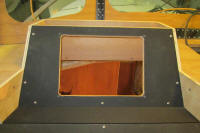 |
Next, I laid out the lower instrument panel, using my
original mockup as a basic guideline. All the
other installations here would register off the engine
instrument panel, so I cut that opening first and
temporarily installed the panel so I could ensure proper
alignment of the other components.
I positioned the cutout template for the engine controls
to starboard, but eked the template a little bit closer
to the engine panel to increase throttle lever clearance
inside the nav enclosure, maintaining 3/4" distance
between the throttle housing base and the engine
instrument panel.
|
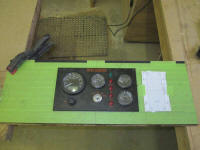 |
My last mockup had placed the autopilot control head
(Simrad AP24) to port of the engine panel, and I'd gone
back and forth about what else, if anything, to install
in the remaining space. Here I had an 11th hour
epiphany: I thought the VHF radio would fit in
this space as well. My last plans had the VHF
located in a
small overhead console on the centerline, but that
had raised some issues with the size and shape of that
particular box, as well as conflicts with the overhead
hatch/skylight and other complications, details of which
I'd planned to deal with later, but I'd never loved how
the mockup overhead box had turned out, though I'd not
thought about it for several weeks.
Excited by the idea of installing the VHF in the lower
panel, I decided to use my old mockup plywood panel to
install the actual electronics (autopilot and VHF) to
confirm that the idea would work in my actual
installation. It did, but because I'd kept
the autopilot control head even with the top of the
adjacent engine panel, the VHF was pushed down a bit
closer to the bottom edge than I wanted. |
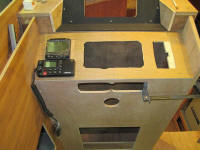 |
To deal with this issue, I decided to center the two
components in a vertical orientation, ignoring the
alignment with the engine panel. This gave me more
space, raised the VHF to an adequate distance above the
bottom edge of the panel, and increased the clearance
between the two components. This new layout
also meant that I could build a much slimmer overhead
electronics box to hold the two low-profile instrument
heads required there (as well as possibly a small backup
GPS). |
 |
Pleased with the layout, I made the required cuts and
installed the panel. |
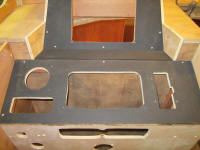 |
Meanwhile, I laid out and made a few cuts for several
installations in the vertical console face, including
two controls for the heating system, three fuel gauges,
and a bilge pump control. |
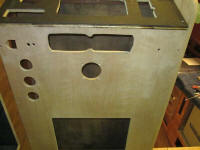
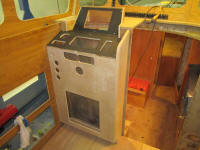
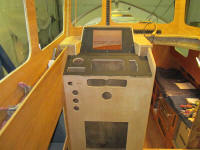 |
For self-satisfaction, I installed all the actual
components temporarily to see how it looked, omitting
the electrical panels for now. |
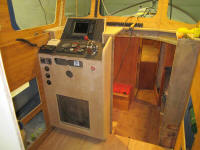
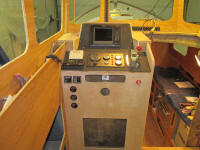
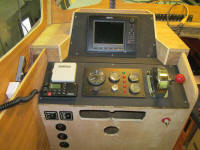
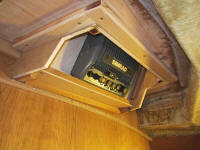 |
There were a number of details remaining, including
additional panel coverings and trim, so to prepare for
that work I removed all the electronics and stowed them
away again. Next time, I'd work on some of the remaining
details.
|
Total Time Today: 6.75 hours
|
<
Previous | Next > |
|
|
















